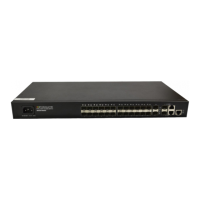Configuration File Management
Chapter 26. Configuration File
Management
26.1 Introduction to Configuration File
Configuration file records and stores user configurations performed to a switch. It also
enables users to check switch configurations easily.
Upon powered on, a switch loads the configuration file known as saved-configuration file,
which resides in the Flash, for initialization. If the Flash contains no configuration file, the
system initializes using the default settings. Comparing to saved-configuration file, the
configuration file which is currently adopted by a switch is known as the current-configuration.
A configuration file conforms to the following conventions:
The content of a configuration files is a series of commands.
Only the non-default configuration parameters are saved.
The commands are grouped into sections by command configuration mode. The
commands that are of the same configuration mode are grouped into one section. Sections
are separated by empty lines or comment lines. (A line is a comment line if it starts with the
character “!”.)
The sections are listed in this order: system configuration section, physical port
configuration section, logical interface configuration section, routing protocol configuration
section, and so on.
A configuration file ends with an “exit”.
26.2 Configuration File-Related
Operations
You can perform the following operations on an S6424-S2C2 switch:
Modify uploaded configuration file. The configuration file is in the form of text, which can be
uploaded to the PC through FTP and TFTP. Please use text tools (such as windows notepad)
to edit the uploaded configuration file.
Modify and save the current configuration to a configuration file.
Removing a configuration file from the Flash.
Execute saved configuration file.
Checking/Setting the configuration file to be used when the switch starts the next time.

